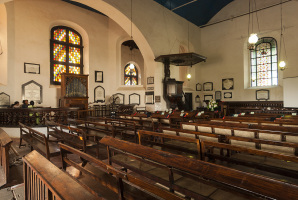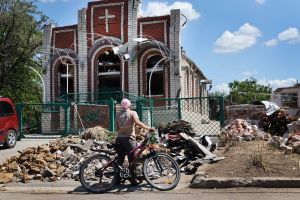Rita Evacuees Head Home; Relief Efforts in Full Swing
As streets began to dry yesterday along the Texas-Louisiana coastline, tens of thousands of evacuees began returning to their homes - some destroyed, some just a little wet- despite the requests of officials to ''stay put.''
As streets began to dry yesterday along the Texas-Louisiana coastline, tens of thousands of evacuees began returning to their homes – some destroyed, some just a little wet – despite the requests of officials to “stay put.”
“Don’t come back into southeast Texas today,” said Texas Gov. Rick Perry, who went on a helicopter tour of damaged areas yesterday.
Houston officials had devised a plan to bring the evacuees back home, dividing the city into four quadrants and asking residents to return to each section one at a time, beginning with the northwest – a request that some felt to be unreasonable.
"I am not going to wait for our neighbors to the north to get home and take a nap before I ask our good people to come home," Judge John Willy, the top elected official in Brazoria County, said in a statement. “Our people are tired of the state’s plan! They have a plan too and it’s real simple. They plan to come home when they want.”
Traffic conditions were heavy on Sunday for motorists heading back to Houston, where 2.5 million residents had been asked to evacuate last week prior to Rita’s landing.
Gasoline containers were strapped to the roofs of many vehicles, while police officers stationed every few miles helped stranded drivers, reported the Associated Press (AP).
Those who made it back to Houston found business reopened as well as airports, with the city’s services and schools planning to resume this week.
In the coastal areas of Texas, however, including Port Arthur and Beaumont, scenes were grimmer, with uprooted trees cluttering streets lined with demolished homes.
“Look at that,” Perry told CNN, pointing to a badly damaged private aircraft hangar during his helicopter tour. “It looks like a blender just went over the top of it.”
Damages in Texas have been estimated at more than $8 billion, a sum that Perry predicts the government will pay in full.
Over one million customers in Texas were without power on Sunday with the Texas Air National Guard coordinating response efforts, Texas emergency operations director Jack Colley told CNN yesterday.
Colley said that basic goal at the moment for Texas relief operations is “food, water, ice and medical support to our communities.”
Floodwaters began receding on Sunday in New Orleans – a city that has been battered by two major hurricanes in the last 3 weeks.
Areas reflooded by Rita could be pumped dry within a week, far sooner than originally predicted, city officials told the New York Times yesterday.
More than just flooding, however, Rita’s winds and 15-foot storm surge also left numerous small fishing communities around southwestern Louisiana decimated.
“There's really hardly anything left," Gov. Kathleen Babineaux Blanco told the New York Times about the town of Cameron. "Everything is just obliterated."
Louisiana officials will ask Congress for more than $31 billion to rebuild and improve levees and major roadways damaged by Katrina and Rita, Blanco told CNN yesterday.
But while Rita left much debris in the cities that felt its impact, it did not leave the massive death-toll that its predecessor, Katrina, did when it made landfall on Aug. 29.
Only two known deaths have been caused by Rita so far, a man whose mobile home was upended by a tornado in the Mississippi Delta and a man who was hit by a falling tree in Angelina County, Texas.
“The evacuations worked,” David Paulison, acting director of the Federal Emergency Management Agency, told AP.
President Bush visited with officials on Sunday at Randolph Air Force Base in San Antonio, Texas to discuss the Federal government’s response to Katrina and Rita, proposing that the Department of Defense should become the lead agency if a natural disaster of a “certain size” were to come about.
Federal and volunteer relief responders have been on site since Rita made landfall on Saturday, providing essentials such as food, water, ice, and medical aid to those in need.
The American Red Cross, which is currently setting up shelters for those displaced by Rita, has projected at least a $2 billion tab to cover the response to Hurricane Katrina, and untold additional expenses for Hurricane Rita. So far the organization has raised nearly $854 million, and already spent or committed $700 million for Katrina relief.
“We have a long way to go in our fundraising to meet the needs of people from Katrina, let alone what we need to do for the people of Rita," Joe Becker, senior vice president of preparedness and response with the Red Cross, told reporters in Washington. "As fast as the money is coming in, we are spending it."
The Salvation Army – the second largest disaster relief organization in North America, behind the American Red Cross – have opened up two shelters in the north Houston area where more than 450 mostly low-income residents who were unable to evacuate the city found refuge before the storm made landfall. The organization is also providing thousands of hot meals to evacuees in shelters in Amarillo, Lubbock, Dallas, Lufkin and Austin.
“Before the storms come, during the storms and well after the storms have gone, The Salvation Army is prepared and ready to respond with meals, water, shelter and personnel trained to help people and communities,” said Major George Hood, the Salvation Army’s national community relations and development secretary, in a statement released on Saturday.
Also aiding in the relief effort for Rita is The United Methodist Church, who released a panoply of resources on Friday to help its members “Be the Hope” for those affected by Hurricanes Katrina and Rita.
The church offers “a community of support, safety and security when catastrophes disrupt the lives of individuals in affected areas,” said the Rev. Larry Hollon, chief executive officer of UMCom. Those who volunteer to assist survivors “personify that hope and concern of the larger community.”
“If you contribute to the United Methodist Committee on Relief for long-term relief, if you put together flood buckets or hygiene kits, if you join in prayer for those who are affected, if you volunteer to help in cleanup or operate a shelter, or encourage friends or the place where you work to make a financial contribution, you are being a concrete manifestation of hope,” he said, according to the United Methodist News Service.
Resources include worship materials, counseling tips, prayers, web tools, and bulletin inserts.
The Evangelical Lutheran Church in America, the Christian Reformed Church, the Presbyterian Church USA and the World Evangelical Alliance also released helpful reflections on the hurricanes that churches can use for counseling and response.
One resource, provided by the Evangelical Lutheran Church in America, is a radio clip titled, “God, We Need to Talk.” The program features the Rev. Peter Marty, who talks about making sense of how God’s will goes to work in times of devastation. The entire 25 minute program is available to stream on the ELCA’s website: (http://www.elca.org/disaster/resources/05-09-01-katrinaprayer.asp)
To give to the United Methodist Church, visit: www.methodistrelief.org
To give to the Evangelical Lutheran Church in America, visit: www.elca.org/disaster/giving/
To give to the Red Cross, visit www.redcross.org
To give to the Salvation Army, log on to www.1800SALARMY.org or call 1-800-SAL-ARMY.





























